As I’ve said many times before, Ruger produces firearms to match the budget of blue-collar workers. However, that’s not to say, they aren’t suitable for anyone – they are. Ruger produces some of the most over-built firearms in the world, and that’s a good thing in my feeble mind. I like the fact that, Ruger firearms are not over-priced, not in the least, and you can usually find them for a lot less than retail, if you shop around – again, that’s a good thing.
Ruger had a rough start, when they attempted to come out with their first center-fire semi-auto handgun, the Model P85. However, after some bugs were worked out, it was a stellar handgun, built for the toughest conditions you can throw at it. For a time, when I was the chief of police, in a small Oregon town, I carried a Ruger P85, as did the sheriff of our county. Everyone else carried a Glock 17. I went through an executive protection training course, back in 1989. There, everyone who was in my class either had a Glock 17, or a Beretta 92SF – I was the only student with a Ruger P85. The handgun part of the training was tough – on average, we would fire about 1,500 rounds per day – everyone was wearing Band-Aids on their thumbs from numerous magazine loadings. During the course of the firearms training portion, everyone, without exception had some kind of failure with their guns – except me, with the P85. The only minor complaint I had was that, at the end of the training, the finish on my P85 was extremely worn – we started nearly all of our shooting with the guns holstered, so there the leather holsters did cause some wear on the guns.
Ruger has had a string of home runs with their P-series of handguns. That was followed by their polymer-framed pistols have also been quite successful. I owned just about every model of the P-series, and none of them let me down in the least. It was with great anticipation, that I waited for the new American 9mm to come along, and it didn’t let me down in the least – 17+1 rounds of 9mm on-tap – and this gun was designed to meet all US Military Specs for their handguns. However, Ruger didn’t enter the American in the competition – too bad, I think they might have won – because the American 9mm is so rough and tough – it’ll take anything you can toss at it. I owned the American in 9mm and in .45 ACP and much preferred the 9mm version…the .45 ACP didn’t seem to my liking with only 10+1 rounds on-tap…not that ten rounds isn’t “enough” to end more deadly encounters – I just preferred to have more rounds of ammo in my gun. Not a thing wrong with the .45 ACP version – not at all. I still own one.
Today, we’re looking at the new American Compact 9mm LEO Model. “LEO” is an acronym for Law Enforcement Only, and I don’t believe that sales are actually restricted to Law Enforcement Officers. But it has some really nice added features that the “regular” American Compact 9mm version has – features that are of use for police as well as civilians.
The American Line
The “American” line of handguns from Ruger are all striker-fired. I’ve learned to love striker-fired handguns – first ones just took some getting used to the trigger – a lot different than hammer-fired handguns. One thing that I like is that these guns have a barrel cam that distributes the felt recoil force over a longer period of time, so the recoil doesn’t seem as bad as other handguns. Another plus is that you don’t have to pull the trigger first, to take the gun apart for cleaning – nice touch!
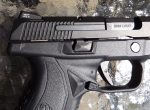 If we start from the top, the barrel is 3.55-inches, and has a tough black nitride coating on it, over its stainless steel body. The front and rear of the slide is angled, and this helps when holstering your pistol…the rear angles are just there to match the front angular slide. There are grasping grooves on the sides of the slide in the rear, for a sure grip when chambering a round. These aren’t coarse, so no worries about it wearing on your clothing. We have a massive external extractor in the slide, and it will pull out the toughest empty brass, or loaded rounds. There are three-dot tritium night sights on the slide and the gun came perfectly zeroed for 25 yards.
If we start from the top, the barrel is 3.55-inches, and has a tough black nitride coating on it, over its stainless steel body. The front and rear of the slide is angled, and this helps when holstering your pistol…the rear angles are just there to match the front angular slide. There are grasping grooves on the sides of the slide in the rear, for a sure grip when chambering a round. These aren’t coarse, so no worries about it wearing on your clothing. We have a massive external extractor in the slide, and it will pull out the toughest empty brass, or loaded rounds. There are three-dot tritium night sights on the slide and the gun came perfectly zeroed for 25 yards.
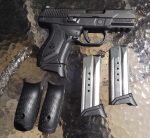 About the frame: It is made out of black polymer, to help keep weight down – the gun only weighs 28.7-ounces. On the slide there is a Picatinny rail for mounting lights and/or lasers, and there are three slots – unlike some other guns that only offer you one slot/position for mounting accessories. There is a fully ambidextrous slide release/stop, and on the left side is the take-down lever. There is also a fully ambidextrous magazine release – I like that – a lot! The trigger guard is curved and not squared off – another design feature that I like. The front and rear straps on nicely textured for a sure grip. This LEO model comes with three easily-replaceable back straps for different sized hands, my sample came with the medium one installed. I tried the small and larger backstraps but the medium one fit my hand perfectly.
About the frame: It is made out of black polymer, to help keep weight down – the gun only weighs 28.7-ounces. On the slide there is a Picatinny rail for mounting lights and/or lasers, and there are three slots – unlike some other guns that only offer you one slot/position for mounting accessories. There is a fully ambidextrous slide release/stop, and on the left side is the take-down lever. There is also a fully ambidextrous magazine release – I like that – a lot! The trigger guard is curved and not squared off – another design feature that I like. The front and rear straps on nicely textured for a sure grip. This LEO model comes with three easily-replaceable back straps for different sized hands, my sample came with the medium one installed. I tried the small and larger backstraps but the medium one fit my hand perfectly.
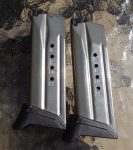 The LEO American Compact comes with three, 12-round nickel Teflon-coated magazines, and they are easy to load – unlike some other polymer mags, that take two men and a boy to load to full capacity. And, let’s not forget the trigger – it has a blade safety in the center of the trigger, and the gun won’t fire unless you have a good purchase on the trigger and pull it fully rearwards. There are other passive safeties as well. Each of the three magazines come with both a flat mag base plate, as well as a “pinky-catcher” extended mag base plate. I installed the pinky catcher base plates on all of the mags. Those just give me a much better purchase on the gun when shooting. There is no manual safety on this model, and I don’t think its needed. The trigger pull was right at 6-lbs on my sample.
The LEO American Compact comes with three, 12-round nickel Teflon-coated magazines, and they are easy to load – unlike some other polymer mags, that take two men and a boy to load to full capacity. And, let’s not forget the trigger – it has a blade safety in the center of the trigger, and the gun won’t fire unless you have a good purchase on the trigger and pull it fully rearwards. There are other passive safeties as well. Each of the three magazines come with both a flat mag base plate, as well as a “pinky-catcher” extended mag base plate. I installed the pinky catcher base plates on all of the mags. Those just give me a much better purchase on the gun when shooting. There is no manual safety on this model, and I don’t think its needed. The trigger pull was right at 6-lbs on my sample.
The American handguns, full-sized and compact, come in a very sturdy black polymer case, that holds the spare mags, as well as the backstraps, so you are ready for a trip to the range. I like the polymer carrying cases, over cheap cardboard boxes, that don’t last very long, Ruger is doing it up “right” in this regard.
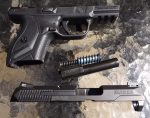 The American Compact – and full-sized pistols – are rated for sustained +P ammo, and believe me, these guns can take all the +P you want to throw at them. I had a great selection of 9mm ammo from Black Hills Ammunition – as a matter of fact, I had every type of 9mm they currently produce – some were only a few rounds, but most were full boxes to run through this little gun. I had their 100-gr HoneyBadger +P load and this is an all-copper milled bullet that doesn’t expand, but it gets the job done just as well as JHP does. I also had their 125-gr HoneyBadger, and this one is subsonic. The 115-gr JHP +P, 124-gr JHP +P, 115-gr FMJ, 115-gr EXP HP, 124-gr JHP and lastly, their 115-gr Barnes TAC-XP +P load.
The American Compact – and full-sized pistols – are rated for sustained +P ammo, and believe me, these guns can take all the +P you want to throw at them. I had a great selection of 9mm ammo from Black Hills Ammunition – as a matter of fact, I had every type of 9mm they currently produce – some were only a few rounds, but most were full boxes to run through this little gun. I had their 100-gr HoneyBadger +P load and this is an all-copper milled bullet that doesn’t expand, but it gets the job done just as well as JHP does. I also had their 125-gr HoneyBadger, and this one is subsonic. The 115-gr JHP +P, 124-gr JHP +P, 115-gr FMJ, 115-gr EXP HP, 124-gr JHP and lastly, their 115-gr Barnes TAC-XP +P load.
Compact, But Chunky
Even though the American Compact 9mm is considered a “compact” handgun, it is a little bit on the chunky side. I thought I’d do my accuracy testing at 25-yards, over a rolled-up sleeping bag over the hood of my pick-up truck. I did a lot of informal target practice to start with, taking pot-shots at rocks downrange and tree branches, and during my function testing, I ran six mags through the gun as fast as I could pull the trigger – I picked-up some more spare mags. The gun got a little bit hot, to say the least, but it never missed a beat, with any of the ammo – then again, I expect no less from Ruger firearms.
I could easily hit large rocks out to 50 yards and beyond, so this gun is a shooter. And I love the night sights – even during the daytime hours. I love the 100-grain version of the Black Hills HoneyBadger load. However, it wasn’t the most accurate load in the American Compact. The HoneyBadger 125-gr load was giving me 3.5-inch groups without much effort and very little recoil. The 124-gr JHP +P load is a favorite of mine from Black Hills – it’s just a good all-around load – great self-defense round. I also think very highly of the 115-gr Barnes TAC-XP +P load – this is an all-copper hollow point.
The overall winner for accuracy was the 115-gr FMJ load – and it gave me groups right at 3-inches if I did my part. I had a few groups just a hair below that. However, the 124-gr JHP (not +P Load) was hot on the heels of the 115-gr FMJ load – gave me pretty consistent groups of 3.50-inches. In reality, you can’t go wrong with any of the Black Hills loads. They produce premium pistol ammo – not cheap plinking ammo. There is a difference, believe me. In all, I fired more than 300-rounds in my testing – would have fired more, but no volunteer shooters – we still have this Coronavirus to contend with and I keep a social distance and then some.
The Ruger American Compact 9mm LEO retails for $713 and worth every penny of it. There are of course other variants without the tritium night sights that catalog for a lot less money. But I do recommend getting this model with night sights, if you can afford it.
I’ll be reporting on the new American Compact .45 ACP in the near future, with the battleship gray frame and slide. It’s a winner from my limited testing with it already.

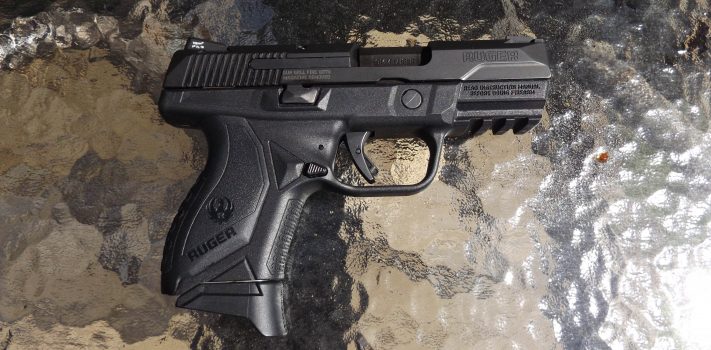









Thanks, Pat, for a great article! I’m quite fond of Rugers, and have owned several of them (M77-30.06, 10/22, and Sec. Six) for many years.
More recently, I inherited a Ruger P91DC (.40 S&W) from my father. Before his passing, Dad had mentioned that this pistol was built very rugged and would safely handle just about any kind of +P load.
After reading your article, I’m now interested in researching more about the P91DC to see how it might differ from the P85, or others in this series. If you have any additional insights or experiences in this regard, I’d be most interested in hearing them. Thanks again!
Good review of a pistol I did not know existed! I counted up all of the Ruger firearms I own and it stands at 7. All of them are very good shooters and were reasonably priced as Pat points out. For the money you get a very decent product with Ruger. I have really wanted to get an American Competition model in 9mm but with this shortage of semiauto handguns and ammo ( although I reload and as a prepper have more than enough 9mm to last until doomsday ) have been unable to get one. But this review piquets my interest also. To tell the truth I have at least 4 compact 9’s already but hey a guy can always make room for one more, it’s a compact right?
My CCW instructor nudged me to move from revolvers to a semi auto for self defense. I choose the Ruger Security 9 because its magazines will fit the Ruger PC Carbine I hope to get soon. Same mags, same ammo – I strive to keep it simple and reduce parts and stockpiled calibers. Every nice thing said about the American Compact above seems to apply to the Sec 9; and I love it! It’s easy to shoot (and then get back on target due to minimal recoil), fits my hand perfectly, has a lean, snag-free beveled design, and seems solidly built. Fun and 15+1 (or 17+1 with the Carbine’s mag plus a simple slide-on adapter). I’ve shot a pal’s PC Carbine too and found it to be a delight as well. My only “complaint” came yesterday when I took a look at the Security 9 (sub)Compact (their regular Sec 9 is already considered compact despite a full 4″ barrel and 15 rnd mag). The ‘little guy’ is only a tad bit smaller than the regular one, perhaps not worth the reduction to 10+1. But yes, Ruger is making some fine affordable products (low $300 at a show in the fall) that make for a smart, functional system.
i’m liking the glock 43x…better/longer grip with the 10 round mags and there is a company making 15 round mags for it and the newer version, an MOS version has just come out…all it needs now is a rail…